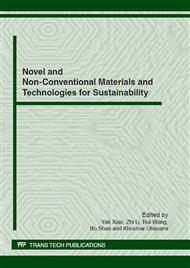[1]
G. Hammond and C. Jones: Inventory of Carbon and Energy, University of Bath, UK (2006) available from http: /www. bath. ac. uk/mech-eng/sert/embodied.
Google Scholar
[2]
G. Roberti and O. Spina: Discrete element analysis on the Sardinian Nuraghe, in Historical Constructions, edited by P.B. Lourenco and P. Roca, Guimaraes (2001).
Google Scholar
[3]
J. van der Meer, S. Nurmohamed, L. Philipse, G. Steendam and J. Wouters: Stability assessment of single layers of orderly placed and of pitched natural rock, available from http: / www. vandermeerconsulting. nl/downloads/risk_assessment/2005_vandermeer_nurmohamed. pdf.
DOI: 10.1142/9789812709554_0403
Google Scholar
[4]
T. Schacher: Bhatar construction; Timber reinforced masonry, technical manual, Swiss Agency for Development and Cooperation, Pakistan (2007).
Google Scholar
[5]
S. Sears: Brick and clay record, available at http: /www. ceramicindustry. com/Articles/Brick_Structural_Clay.
Google Scholar
[6]
CIRIA, CUR, CETMEF: The rock manual. The use of rock in hydraulic engineering (2nd edition). CIRIA, London (2006).
Google Scholar
[7]
UNFCCC: Clean development mechanism-project design document form. UNFCCC (2006).
Google Scholar
[8]
Sydney Water: Boral makes every drop count. The Conserver (Sydney Water, 2006).
Google Scholar
[9]
A. Woodward and B Iskra: The environmental impact of building materials. Victorian Assoc. of Forest Industries, Australia (2006).
Google Scholar
[10]
E. Alby, E. Smigiel, P. Assali, P. Grussenmeyer, I. Kauffmann-Smigiel: Low cost solutions for dense point clouds of small objects. 22nd CIPA Symposium, Japan (2009).
Google Scholar
[11]
T. Deyle: Information available at http: /www. hizook. com/blog/2010/06/20/low-cost-depth-camera-update-microsoft-kinect-november-others-follow-shortly (2010).
Google Scholar
[12]
H. da Gama Leitão, J. Stolfi, Automatic reassembly of irregular fragments, Tech. Report IC-98-06, Univ. of Campinas (1998).
Google Scholar
[13]
J. Egeblad, C. Garavelli, S. Lisi and D. Pisinger: Heuristics for container loading of furniture. European J. Operational Research (2009).
DOI: 10.1016/j.ejor.2009.01.048
Google Scholar
[14]
J. Egeblad, B. Nilesen and M. Brazil: Translational packing of arbitrary polytopes. Computational Geometry 42 p.269 (2009).
DOI: 10.1016/j.comgeo.2008.06.003
Google Scholar
[15]
S. Longshaw, M. Turner, E. Finch and R. Gawthorpe: Analysing the use of real-time physics engines for scientific simulation: 18th UK Conf. Computational Mechanics (2010).
Google Scholar
[16]
C. Mundell, P. McCombie, A. Heath and P. Walker: Drystone retaining walls: From full-scale testing to construction requirements. 11th International Conf. NOCMAT, UK (2009).
Google Scholar
[17]
Jyh-Shing Roger Jang, Chuen-Tsai Sun, and Eiji Mizutani: Neuro–fuzzy and soft computing: a computational approach to learning and machine intelligence (Prentice–Hall, 1997).
Google Scholar
[18]
William H. Press, Saul A. Teukolsky, William T. Vetterling, and Brian P. Flannery: Numerical recipes in C: the art of scientific computing (Cambridge University Press, 2nd edition, 1992).
DOI: 10.1086/416228
Google Scholar


